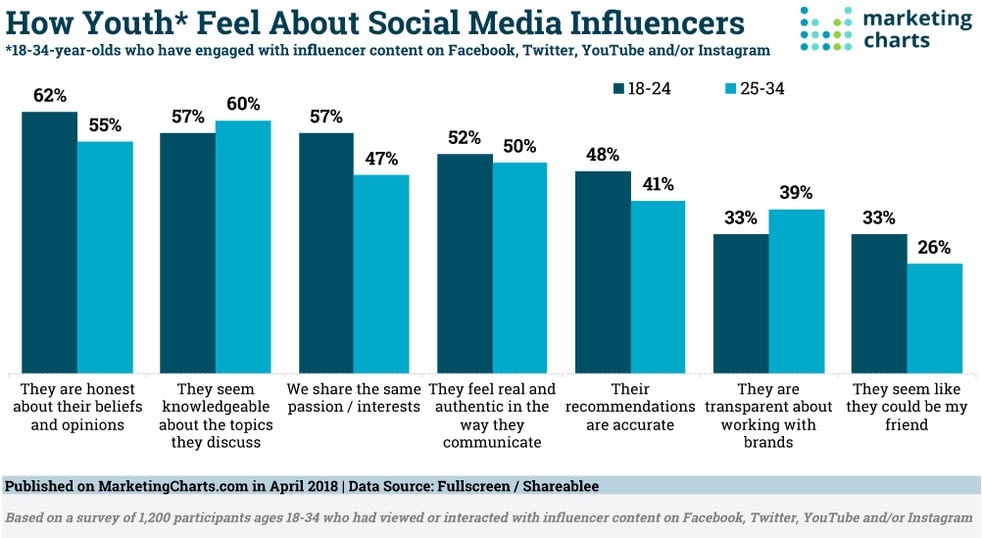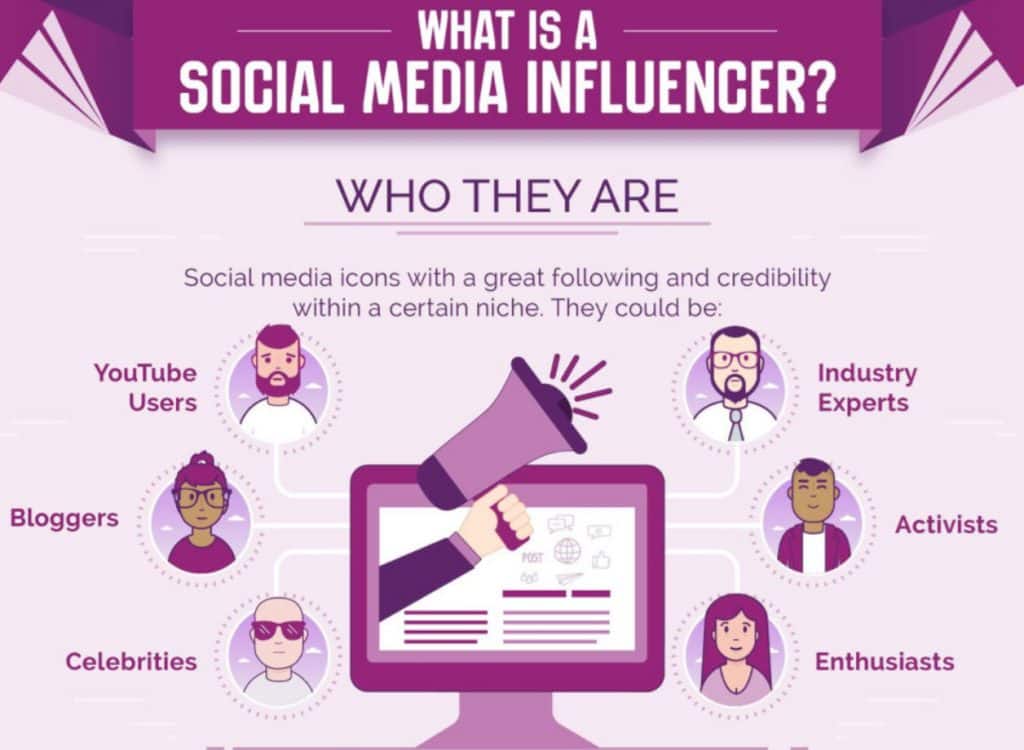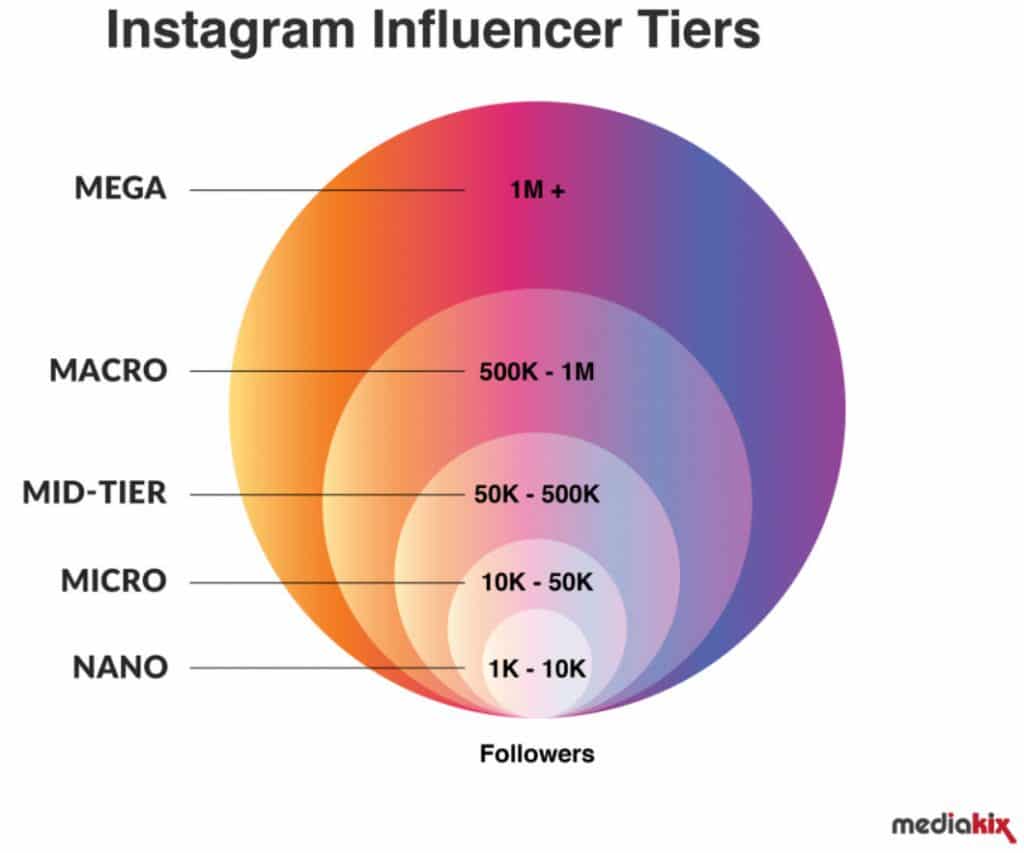Word of mouth is crucial when it comes to promoting your business. This is why using influencer marketing to amp up your channels of promotion is necessary.
A good way to do this is by getting others to help. The right influencer can market your business and increase your word-of-mouth marketing. Here’s how to use influencer marketing to build your brand.
What is influencer marketing?
What is influencer marketing, really? It is when someone who is considered an expert in the field, has a high reputation and helps you market your product. These people may also be considered popular in certain markets and may then be seen as a knowledgeable source. Influencers typically have a sway over the things their followers buy.
Important factor: Influence marketing is the development and delivery of advertising messages through influential people, opinion leaders, and not through the brand itself. They influence by example, more so than using word of mouth to explain why someone should buy the product.
This is not a new marketing strategy. In fact, you’ve probably been exposed to many influencer-created content over the past few years. But, with the growth in social media, there has been a great influx of influencer marketing.
This marketing strategy has grown significantly because marketers have realized that an influencer’s reach is quite large. Even those with smaller reach, with high credibility, can have a pretty big influence for a brand.
Why is influencer marketing important?
Now that you understand the basics of this concept, it’s understandable to wonder why use influencer marketing for your brand? The practice of promotion through an influential public figure is not new. But in the past it was quite transparent – although the advertisements corresponded to the patterns of authority and sympathy, it was obvious that it was paid and inauthentic. The closest relative of the current advertising influence is product placement in TV shows and movies.
Dozens of studies prove that millennials do not trust traditional advertising. And not only millennials, although they are the most difficult to access by traditional means. There is plenty of evidence that most demographic groups do not trust advertising messages. In short, we want brands to become more authentic.
This trend affects not only print and television advertising. Traditional online advertising formats are also not always effective. This does not mean that all advertising has become useless (of course not), but banner blindness and a wave of consumer mistrust, along with an increase in competitive advertising costs, have led to a decrease in the effectiveness of traditional campaigns.
With the loss of trust in advertising and the growing influence of social networks, what we call today “influence marketing” has emerged. This method is less transparent in motives, but more authentic.
What does this all mean?
What does it mean to use influence over word of mouth? Well, it means that these people are not strictly saying “you have to try this,” “you’d like this,” “you need this.” Instead, they are simply showing off how they use the product. Real world examples, from the influencer that relates with their audience.
While people admire celebrities and want what they have, some of these influencers are down to earth and have deeper relations with their audience. An example would be watching an influencer recommending laptops for students. They’ve watched and learned his or her expertise on a laptop for a while and when it comes to deciding what laptop to buy, they go to that influencer for a recommendation. We mentioned in our referral program statistics, 92% of consumers from various markets are more inclined to believe people who are in their circles. Influencers are a part of that circle.
You may also notice when certain celebrities or other people who have a large following to promote certain products or brands on social media. Whether audiences are die-hard fans, do or buy whatever celebrities buy, it all boils down to how can brands be more relatable with their customers. This is sort of like a celebrity endorsement. We’ve written an article to explain the difference between advocate, ambassador, influencer and relationship marketing, if you like to know more.
The effectiveness of this type of marketing
According to research, 94% of marketers who use influencer marketing find it an effective practice, and influencer marketing can generate up to 11 times the ROI of traditional advertising. Our experts show influencer marketing as their 2nd priority, after content marketing, based on our influencer marketing research.
Although sympathy for the leader of opinions is a changeable variable with social diffusion, at the generally accepted level it seems obvious that the opinion of a person whom we trust and whom we respect influences us more strongly than an advertising banner on the Internet.
Influence marketing works in part because it circumvents the shortcomings of other channels. Here’s what Misha Talavera, the founder of NeoReach, says about this in AdWeek:
“We see so much advertising that we unconsciously learn to ignore it. This is called “banner blindness. ” The digital advertising platform Infolinks found that only 14% of respondents could recall the last viewed ad and determine what was advertised there. Given the abundance of advertising, it’s no wonder people like products like AdBlock, Netflix, and Spotify Premium. ”
Nielsen published the results of a study conducted with TapInfluence. It turned out that the return on investment of marketing influence is much higher than that of display advertising – 11 times.
Think for yourself – how do you buy products? Of course, often by “word of mouth” from friends, but surely there are several media people who deserve your trust, to which you listen.
How to find out if marketing influence suits you? Treat it like any other experiment to increase the number of customers. Test the method with short-term tests, measure, analyze and make a decision. Mike Filbey, the co-founder of ButcherBox, discovered the influence of marketing effectiveness as follows:
“When we first started, we had no idea which marketing channels would work – so we tested a lot of options, one of which was marketing influence. From the first email, it became clear that the campaign with an influential person through ButcherBox works well for us. Since then, we have focused on improving and expanding this channel. ”
Check out our article if you want to know more proof of the power of influencer marketing with statistics.
A brief history of marketing with the help of influencers
Influencer marketing isn’t new. In fact, influencer marketing been around for quite some time and gained a lot of momentum in the 20th century. Think about Santa Claus – a historical figure and the face of Christmas, he also happens to be a brand influencer for Coca-Cola.
If you think about it, characters and celebrities have been the face of many brands for years.
- Toucan Sam for Kellogg’s Fruit Loops is fun and energetic, helping influence kids to want the product. He’s been around since the 60’s.
- LeBron James for Nike. He’s a well-known athlete and has been the face of many athletic wear campaigns since his 2003 start in the NBA.
In the past years, influencers were primarily made up of famous people. But, because of social media, many new influencers have emerged. Now, an influencer can be a social media user who has a large following. And actually, many social media influencers develop fame and have become actors, models, and musicians just from their influence on social sites.
Why have influencers help market your business?
With global ad fraud traffic on the rise, the pursuit and the demand for pure and true organic growth is always growing. We live in an age where people adore celebrities, media personalities and people of influence. Thanks to the internet and in particular social media, people have live updates and gets to follow their role models do what they do best. Their choice of brands, what they like to do, activities they do engage in and their opinion on different subject matters does matter a lot.
It’s here where influencer marketing comes in or let’s say it’s here where marketers or brand producers get to take advantage of this. Influencer marketing refers to the promotion of a product or an idea through the use of a person of influence. They can influence the decisions of hundreds and thousands of people.
The foundation of this type of marketing
The very foundation of influencer marketing or where it draws its approach is this; it’s very easy to influence a person or group of people who are already influenced by a certain person. For example, lots of famous music celebrities have a ton of followers on their social media platforms and if they get to endorse a certain brand it will surely have common ground among their followers.
How to do influencer marketing involves identifying personalities who have potential influence or opinion over potential buyers and then goes on to orient marketing activities around such individuals. A good example of this is when various authors or book publishers took advantage of Oprah Winfrey’s celebrity status and the large viewership she enjoyed on her shows and used her to promote their books and it wasn’t a surprise that their books were sold out.
How does this type of marketing work?
Influencer marketing uses key leaders to drive a brand’s message to the intended target market, and for this reason, brands tend to associate themselves with personalities who lean most towards their objectives. Influencer campaigns are meant to tap into the existing market or community of engaged followers and you have probably seen this through famous bloggers and YouTubers who actively advertise market brands to their followers. The image above provides a helpful guide on how to do influencer marketing for visual learners.
Influencer marketing conforms to a popular business law that states that the marketplace will always adhere to the opinion of an influencer without any rejection, a law that makes influencers be a prized asset among market brands. Influencers enjoy a solid following from social media platforms and they do make a notable impact in their online communities, these individuals play the role of journalists, content writers, entertainers and advisers and are normally connected to a network of other popular individuals who are also regarded as influential.
Whenever influencer posts an update it will most definitely be viewed and read by many people and it’s here where business benefits do lie. And if these personalities do speak on your brand or idea, then your brand will definitely reach out to the followers. Apply influencer marketing best practices for the best outcome.
Who uses this kind of marketing?
Brands of all sizes use influencer marketing. You may see an influencer talking about a big brand name, like Nike, Revlon, or even Colgate. On the other hand, you may see smaller boutiques, and specialty goods, like a local jewelry maker or organic dog treat shop being promoted by influencers as well. Obviously, you are also wanting or using influencer marketing if you came across this article :).
Who is an influencer?
Celebrities are big social influencers. They are not the only ones, though, bloggers, Instagrammers, Youtubers, and other social media stars can be very influential to people. These people are seen as having valuable opinions to their followers. Their influence is more genuine and authentic to their followers.
Influencers are usually specialists in a particular niche and have already earned a high level of trust with their followers, their fans trust their choice of endorsements and in fact, someone will easily attract attention by using the products the influencers have endorsed. In many scenarios, influencers do agree to a contract with the brand they tend to affiliate themselves with, but its not just a simple matter of signing an agreement contract. Influencers will affiliate themselves with brands that do reflect their own choices or opinion so as not to alienate their followers.
Influencers are not limited
Unlike other traditional methods of advertising, influencer marketing is quite powerful and to a large extent, it does influence the purchasing decision of customers. But please note that influencer marketing is not just limited to celebrities or people of influence, it can also be done by a brand’s regular customers. After having an amazing experience of using a certain product, a customer can recommend it to his or her friends making the product a popular brand.
Who can be an influencer?
Before you jump into learning how to do influencer marketing, it’s helpful to learn more about typical influencers. Almost anyone can be an influencer. There is a catch, however, most brands look for influencers who are ‘knowledgeable’ about their type of product. For example, a makeup brand looks for influencers who are either well-known in the field, like a celebrity, or who are really good at using their types of products.
Covergirl, for example, may ask a beauty vlogger to be an influencer for them, rather than a vlogger who’s a channel is about cooking.
Even influencer in the same niche won’t be considered. A makeup vlogger on YouTube who’s vegan and organic, won’t promote any makeup product, or the brand might not work with the vlogger based on their specific-niche space.
Above all else, and said best by G2 Crowd ‘s influencer marketing guide, “Character is an insanely important aspect of influencer marketing”. With that being said… There are a variety of people that make the cut for being an influencer.
- Celebrities
- Content creators
- Thought leaders
- Industry experts
- Micro influencers
Marketing relations with opinion leaders
Fine tuning just who are influencers, there are three types of influential persons: celebrities, macro-influences, and micro-influences. Celebrities, for example, are the athletes, musicians, and actors you used to see. They have more than 1 million followers (average between several social media platform) with an engagement level of 2-5% per post. In general, they have the highest coverage, but, as a rule, the lowest interaction. Also, because of their great attractiveness, they are rarely suitable for reaching a specific target audience. Advertising through such celebrities is like buying TV advertising in a large network.
Macro influencers are often times celebrities who have up to a million followers. They handle many different aspects in their videos as well as postings which involves from 5–25% of the audience for each message. They are also often role models for other influencers. Macros set trends with their content and are copied by micro influencers depending on the popularity of the content.
Micro influencers are users of social networks who are not like ordinary celebrities, experts and public figures.
Want to read more on who you should you use for your business? Macro influencer vs. Micro Influencers?
These are people who work or specialize in a particular area and often share their interests with other users of social networks. Unlike traditional influencers, micro influencers have a more modest number of subscribers.
Their audience is thousands or tens of thousands of people, but their involvement rates are quite high.
For example, a macro-influencer on yoga can have millions of subscribers and several yoga studios. The micro-influencer on yoga has only a few thousand subscribers, and at the same time, that influencer publishes an exercise video for their subscribers on Instagram. But in relation to the number of subscribers, has a very high involvement.
Do not discount this segment. After all, it is about trust and involvement. Studies show that modern teens trust YouTube stars more than world celebrities. The question is which demographic groups you want to achieve – based on this, choose the type of opinion leader.
Like everywhere else in marketing, the more precisely you target an audience, the cheaper it will be to achieve it. Thus, micro influences can be super-relevant to your audience and are relatively inexpensive.
What’s in it for influencers?
Influencers aren’t like brand ambassadors and advocates, meaning they aren’t doing this stuff for free. In an influencer program, it’s expected that the influencer is compensated in some way. Though they might actually love the product, they are motivated to participate because of the incentive. But, to be fair, most influencers only participate in influencer programs that align with the things they like anyway.
Some common incentives:
1. Free product: Usually, the brand will provide the influencer with a product to try, promote, and review.
2. Cash: This is sometimes an additional bonus to the free product. High profile influencers, typically, make some serious cash.
3. Exposure: The brand may promote the content created by the influencer. Further broadening their exposure. Thus making them more marketable for other influencer programs.
How to successfully harness the power of influencers
Running a great influencer program takes a little work, like all other marketing campaigns. Yes, you are getting others to create the content and promote for you. But, you have to set it up for success before any of this can occur. Here are five steps to help you learn how to do influencer marketing effectively.
- Defining your goals is a critical step in influencer marketing. It’s overlooked often, but with any marketing campaign, you’ll need solid metrics to follow so that you can keep a lean strategy and identify what is working and what is not. Whether it is clicks, impressions, conversions, or followers, you have to discuss with the influencer what your goals are on both ends, and tailor your campaign to hit those goals. By having goals in mind, you can create a program that works. If your goals are too vague, you might not get the results you want to see. The goals you set are going to determine what tactics you decide to use for the campaign. If you are having a hard time finding what goals to track, you can also go through several influencer software to help understand what they are tracking and how you can use their software to identify key metrics.
- Is there an influencer marketing software that aids the whole process? There are influence marketing softwares that are designed to bridge the gap between brands and influencers. What these platforms do is to connect your brand with influencers who will then market the brand to their followers. These platforms and software analyze your brand, research on its niche and then link the brand up with an influencer who affiliates with that market niche, creating an amazing brand awareness approach. They can help you do everything from getting an influencer to tracking the influencers reach, and even help issue rewards. Some common ones include Tapinfluence, Famebit and Respona.
- Weed out those who are unfit. Not everyone has what it takes to be an influencer. Brands have to be picky here. They must find the right influencer who will represent them fairly, someone who has a good influence or following, and that person has to fit into their niche. Luckily, most influencer marketing programs ran by software have influencers submit a form. So all the brand has to do is filter through and pick who they like.
- Clearly define your milestones. Before you begin a journey with anyone, you have to set clear expectations. Most brands that run influencer programs make sure their influencers know what to expect before they even start their journey. Everything from what is expected of the influencer to do, to rewards and compensation is laid out.
- Follow up with your follow-ups. If you found the right influencers, you’ll see some comments regarding your brand. This is where your opportunity shines and show them the level of support you have for the influencer and build more relationship with the influencer’s audience. Matching your tone with the influencers and your brand needs to be on point so that you can spark their interest.
Impact of marketing cost and ROI measurement
We have already discussed the effectiveness of marketing influence. Nevertheless, almost any advertising channel will show good results if you invest enough money and time into it. The real question is: what is the cost and marketing impact of marketing?
One of the most effective data-oriented marketing activities is an experiment across all channels. Mostly – on new channels, in order to find the desired market of the “blue ocean” earlier than anyone else.
You are a data marketer, so you probably already know that measuring impact is extremely difficult. However, over the past few years, large platforms have emerged for tracking and optimization, including marketing influence.
There are five indicators used to analyze the impact of marketing ROI:
- Cost per impression (CPI)
- Cost per engagement
- Click through rate (CTR)
- Lead cost (cost per lead)
- Attraction cost (cost per acquisition)
The first three are micro metrics at best, and the fourth does not show the full picture. By the fifth indicator, we can see that industry-wide influence marketing is really good compared to other channels.
In addition, micro influencers show the best profitability of each dollar invested:
How do you track your campaigns?
An essential aspect of learning how to do influencer marketing involves tracking your campaigns. If you’re getting into influencer marketing, just how do you measure up the results? Well, we asked our marketing experts how they run a successful influencer marketing campaign if you want to read more.
There are also platforms for measuring and managing opinion leaders, such as NeoReach and TapInfluence.
But for the rest, campaigns to track down “influence” are very similar to other marketing campaigns. You use the correct labeling, and if you want to go deeper into the analysis, you can use attribution models that go beyond the last click.
If you assign an attribute only to the last click, then you miss a significant part of the awareness process. For example, someone from celebrity brings many new visitors who have not heard about you before, but to convert them you need several touch points (email, organic traffic, etc.) Then it’s more likely that return on investment will be higher than Google shows you Analytics.
Here’s a full list of influencer marketing software you can review that best fit your needs.
The ups and downs of influencer marketing
There are plenty of awesome things associated with this type of marketing. Some that you may think of right away is that it can be inexpensive. Really, the only things you may spend money on is providing some sort of incentive to the influencer. Usually, this is a free product, discount, or cash. Or you may choose to supply the influencer with some inventory to give out to people.
For example, a makeup artist may receive a sample of makeup to show off in a tutorial, and they may receive a few other samples to give to their followers. Just as an athlete may receive some sports drinks to hand out to fans. Depending on how much product you give to the influencer, things could get expensive. But, overall, it’s a less expensive way to market your product in general.
One thing to note, many of these influencers get a ton of product emails for them to review, finding the right influencer is one thing, knowing how to approach an influencer is another. Giving the right influencers gift using our influencer gifting guide might help incentive your next partnership.
A downside could be the unpredictability of the influencers. Unlike traditional marketing, it’s hard to predict the actions of an influencer. If the influencer is going through some sort of hardship or has a downfall it may impact how potential customers view your product. A business must be prepared if damage control is needed after a negative fallout with an influencer.
Even if influencers are reliable, it can also be hard to track the sales that influencers help you make. If you don’t give influencers trackable links, determining ROI can be difficult.
In conclusion
As you can see influencer marketing doesn’t fall far from the tree. That is because it’s a brand strategy, like others, that relies on word-of-mouth marketing. The goal is to build momentum for a product or brand. Influencer marketing is one of the innovate approaches used to market various products and services and according to research, also just one of the many referral marketing strategies.
The influencer marketing trend is set to become a $5 to $10 billion market in the next five years. What’s your game plan?
If you think you’re ready to try influencer marketing, be sure to study up on influencer marketing best practices. That way you can set yourself up for success.







